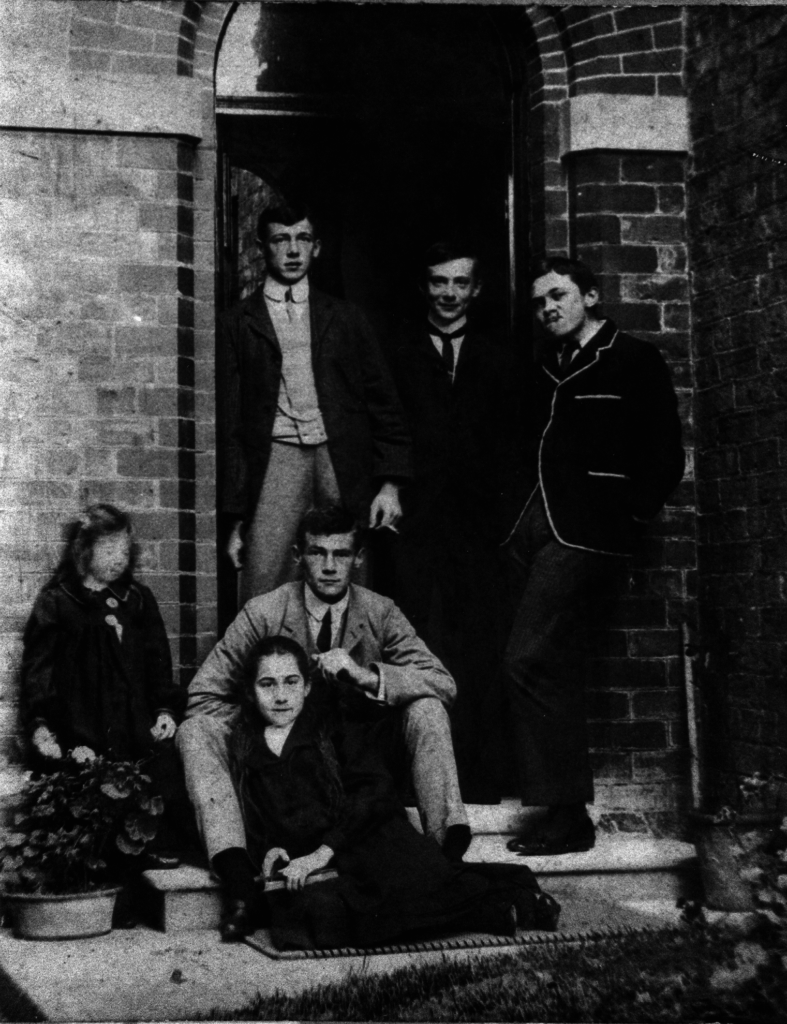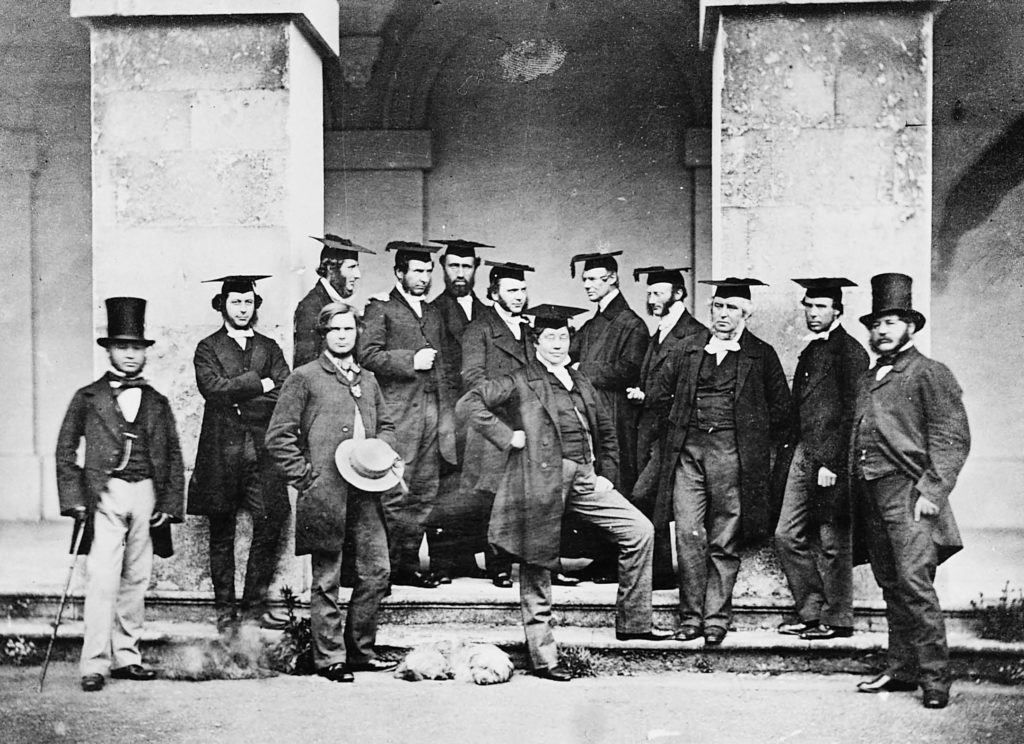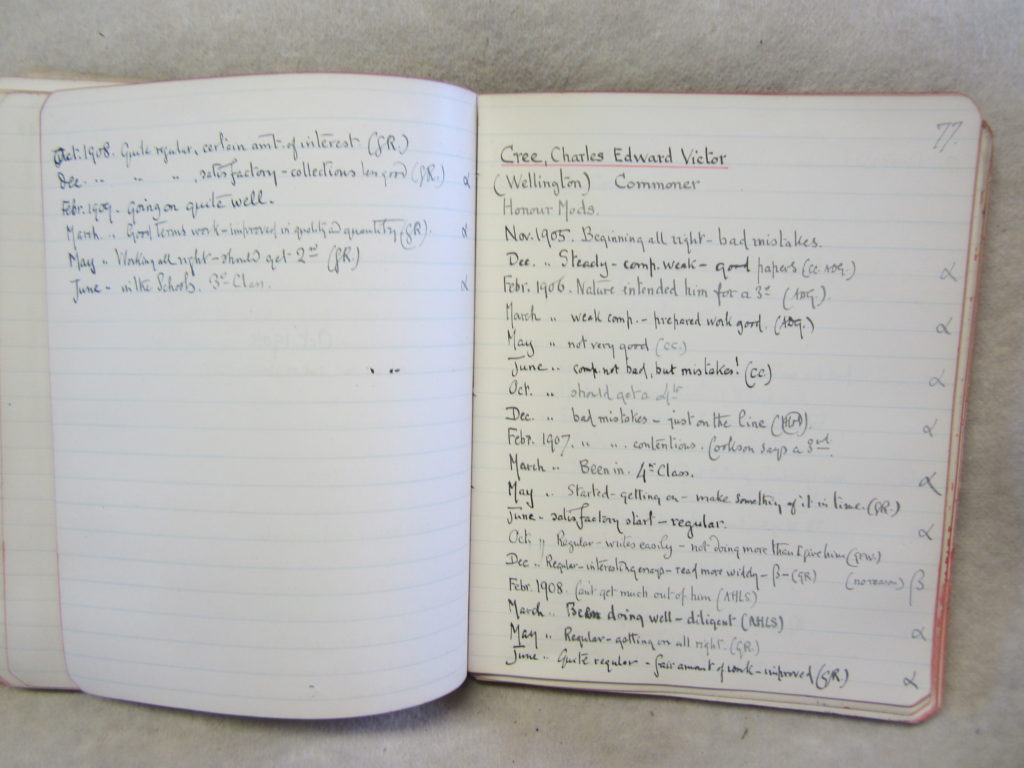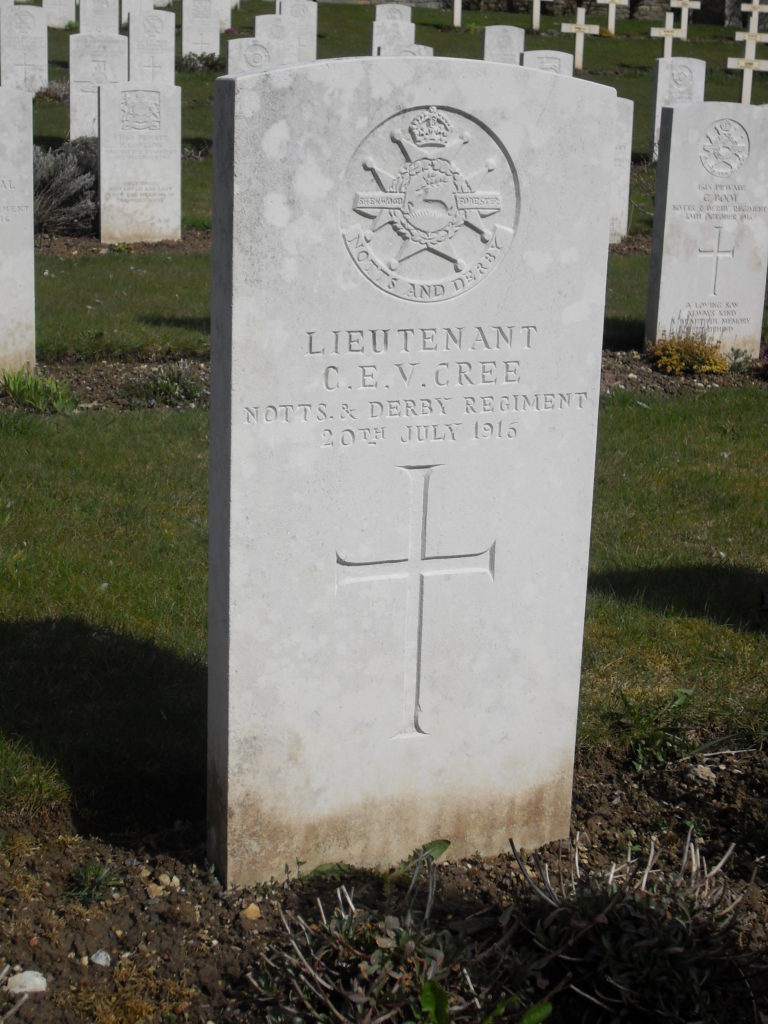Fact file:
Matriculated: 1905
Born: 20 January 1887
Died: 20 July 1916
Regiment: Nottinghamshire and Derbyshire Regiment (Sherwood Foresters)
Grave/Memorial: Bellacourt Military Cemetery: I.G.5
Family background
b. 20 January 1887 at 3, Oak Villas, Bromley Road, Beckenham, Kent, as the fourth and youngest son (six children) of Arthur Walker Cree, BA, MA (1852–1930) and Elizabeth Cree (née Newby) (1852–1928) (m. 1879). At the time of the 1881 Census, the family was living at 3, Oakhill Villas, but by the time of the 1891 Census it had moved to “Brodsworth”, 124, Bromley Road, Beckenham (three servants); it was still living there at the time of the 1901 and 1911 Censuses (six servants). It later moved to Thorn Cottage, Berkhamsted, Hertfordshire, possibly while three of the sons were training nearby with the Inns of Court Officers’ Training Corps.

The Cree children in the porch of 124, Bromley Rd: standing (from left to right): John Francis George; Charles Edward Victor; Arthur Thomas Crawford; sitting (from left to right): Georgina, David, Elizabeth Katherine (Photo © Sir Robin Knox-Johnston; courtesy of Sir Robin Knox-Johnston)
Parents and antecedents
Cree’s father was a solicitor who had studied at Exeter College, Oxford, from 1871 to 1874 and whose practice, Cree & Son, was at 13, Gray’s Inn Square, London; his grandfather, Thomas Cree, had been called to the Bar at Gray’s Inn, and the Crees’ house, “Brodsworth”, was named after the Yorkshire birthplace of both men.
The broader Cree family included several clergymen and military men, and one of Cree’s uncles was the Reverend John Adams Cree (1824–1904), who studied Classics and Mathematics at University College, Oxford, from 1843 to 1847 (MA 1849). He was ordained deacon in 1848 and priest in 1849, and served as the Curate of St Leonard’s Church, Streatham, from 1848 to 1852. From 1852 to 1858 he was the Curate of St Mary the Virgin, Dover, and, simultaneously, a Fellow of Magdalen (BD 1856). But he resigned his Fellowship in 1859 in order to get married and spent the rest of his life as a parish priest in well-endowed livings in Buckinghamshire, leaving over £30,000 in his will.

Magdalen’s Fellows standing outside the New Buildings (1858); the Revd John Adams Cree (Fellow 1852–58) is standing second from the right at the back (Photo © Magdalen College, Oxford; courtesy of Magdalen College, Oxford)
Cree’s mother was the daughter of William Crawford Newby (1808–84) and his wife and cousin Frances Newby (1828–84). Newby was an attorney and Notary Public in Stockton upon Tees and in his obituary he is described as being “prominent among the rapidly thinning band of ‘Old Stocktonians’ who belonged to the pre-industrial days when Stockton was only a flourishing market town”. “Although not a public man”, he “was one of the best known and most widely respected citizens of Stockton.”
Siblings and their families
Brother of:
(1) Arthur Thomas Crawford Cree (1881–1915; killed in action on 12 May 1915 near Brandhoek, in the Ypres Salient, while serving as a Captain in the 7th Battalion (Territorial Forces) of the Durham Light Infantry); married (1907) Ivy Elizabeth Marion Williams (1883–1981); one son, two daughters;
(2) John Francis George (1882–1949); married (1909) Agatha Blanche Carey (1883–1974); one daughter;
(3) David (later Colonel, RE, MC) (1883–1945);
(4) Elizabeth Katharine (1889–1961), later Shelley after her marriage (1915) to Guy Birbeck Shelley (b. 1889 in Sydney, d. 1976 in Antibes); five children;
(5) Georgina Mary (1897–1978), later Hughes after her marriage (1920) to Philip Hughes (1883–1981).
John Francis George studied Law at Magdalen from 1901 to 1904 and then became part of his father’s firm of solicitors. He must have known the somewhat younger C.H. Davies, since the two men were serving in the same Battalion at the time of Davies’s death. John Francis George is mentioned in the Battalion War Diary on 11 January 1916 and was wounded on 1 July 1916. At the time of the 1911 Census, he and his family were living at 64, Park Road, Dulwich. He left £21,323 3s 6d. and at the time of his death he and his family were living at 9, Beulah Hill, Upper Norwood, Surrey.
John Francis George’s wife, Agatha Blanche, was the daughter of a medical practitioner, Arthur Edward Carey (1840–95), and his second wife Blanche Amelia Carey (née Bell) (1855–1938) (married c.1890 in Ceylon). Arthur Edward Carey attended Trinity College, Cambridge, then became a coffee planter in Ceylon, and finally studied Medicine at St Mary’s Hospital, Paddington, London. At the time of the 1881 Census, he and his family were living at 33, Powis Square, Kensington, London SW, and at the time of the 1891 Census they were living at 1, The Crescent, Bedford. They were still living here at the time of Arthur Edward’s death.
David attended Wellington College from 1898 to 1901 and then the Royal Military College (Sandhurst), after which he was commissioned in the Royal Engineers. During World War One, he served in the Royal Engineers with the South Africans in German East Africa. He was awarded the MC and rose to the rank of Colonel.
Guy Birbeck Shelley was a prosperous Australian shoe manufacturer.
Education and professional life
Cree attended the Abbey and Merton House School, Beckenham, Kent (from 1896 Clare House Preparatory School, Beckenham, Kent, now defunct) from 1895 to 1899 (cf. A.T.C. Cree and C.J. Byron), and then, unlike his two older brothers, Wellington College, Berkshire, from 1900 to 1905, where he played rugby for his House and became a Prefect in his final year. He matriculated at Magdalen as a Commoner on 14 October 1905, having been exempted from Responsions.
On the whole, but especially during his first few terms at Magdalen, his Tutors tended to be disparaging rather than encouraging: “Nature intended him for a 3rd”, “not very good”, “should get a 4th”, “Quite regular, certain amount of interest”, and they were right, for when he took the First Public Examination in the Hilary Terms of 1906 and 1907, he was awarded a 3rd in Classical Moderations. But in May 1907, after changing to Modern History, Cree’s performance began to improve and his Tutors’ comments started to become more positive: “Started getting on, [will] make something of it in time”, “Satisfactory start – regular”, “Regular, interesting essays – read more widely”, “Been doing well, diligent”, “Regular – getting on all right”, until, in March 1909, we read: “Good term’s work – improving in quantity and quality”, and in May 1909 “Good term’s work – should get [a] 2nd.” Nevertheless, in Trinity Term 1909 he was awarded a 3rd in the Final Honours School and took his BA on 25 November 1909.

C.E.V. Cree’s academic record (1905–09), compiled by H.W. Greene et al.
(Magdalen College Archives: F29/1/MS5/5)
Cree is, however, an interesting case and one wonders whether, if his tutors had been more concerned with teaching than with judging, he could not have fulfilled their hope of a second-class degree. After graduation, Cree went on to take the intermediate Law Society exam in July 1911, and after passing Finals in 1913 he was articled as a solicitor in his father’s firm in Gray’s Inn Square, London. When making his will, he gave his parents’ address in Beckenham.

Charles Edward Victor Cree
(From: https://derbyshireterritorials.wordpress.com/tag/charles-edward-victor-cree/)
War service
From 29 September 1914 to 3 March 1915, Cree, who was 5 foot 10 inches tall, served in ‘D’ Company in the Inns of Court Officers’ Training Corps (“The Devil’s Own”), where he rose to the rank of Corporal. On 14 September 1914 the unit, including Rowena, its one cavalry mount, had begun training in a camp situated on a sloping field near the railway station at Berkhamsted, Hertfordshire. Arthur Thomas Crawford had been with the unit since the outbreak of war and was promoted Lance-Corporal on 29 September, and John Francis George Cree had joined the same Company on 23 September.
In January 1915, Charles Edward Victor applied for a Territorial commission and on 4 March 1915 he was made a probationary Second Lieutenant in the 1/6th Battalion, the Sherwood Foresters (Territorial Forces; Nottinghamshire and Derbyshire Regiment). The 1/6th Battalion had been mobilized at Chesterfield on the outbreak of war as part of the Notts & Derby Infantry Brigade. After training, mainly in the south of England, it had disembarked at Le Havre on 26 February 1915, where it became part of 139th Brigade, 46th (North Midland) Division and saw action in Ploegsteert/Bailleul/Mount Kemmel. Cree landed in France on 12 July 1915 and joined the Battalion on 8 August 1915 when it was in the trenches near Sanctuary Wood. His commission was confirmed in September 1915.
The Battalion entrained for Fouquereuil on 1 October and three days later arrived at Béthune as part of XI Corps, where it occupied the former German trenches north of Loos. By 12 October, it had moved to the trenches east of Vermelles, near Fouquereuil, where it participated in the final stage of the Battle of Loos. On 13 October the 46th Division attacked the enemy trenches along a line from Dump Trench to the north of Hohenzollern Redoubt with 137th Brigade on the right, 138th Brigade on the left, and 139th Brigade in reserve. At 12 noon the Battalion was moved to 137th Brigade and it launched an attack at 14.00 hours. The Redoubt was captured, but at a cost of 65 men killed, wounded and missing, including the Commanding Officer. From 15 to 19 October the Battalion was in billets at Verquin, then in the trenches at Lapugnoy until 26 October, and then in billets at Béthune, where Cree was promoted Lieutenant on 29 October. On 5 November the Battalion was at Pacant when the 47th (1/2nd London) Division took over the trenches to the right of Neuve Chapelle, and on 9 November it relieved the 3rd Battalion, the London Regiment, commanded by the newly promoted P.W. Beresford with D.W.L. Jones as one of its subalterns, at La Couture, where it stayed until 27 November. Cree would have known neither of these men, of whom one was significantly older and the other significantly younger than himself. After a week’s rest, it spent two more days in the trenches at Richebourg L’Avoué and La Couture, after which it was in billets at Robecq and Boeseghem until 26 February 1916, when it began a two–three-week stint in the Isbergues area, first of all in the trenches at Coulenvillers and then, from 10 February, in billets at Beaumetz. On 19 February, Cree was sent on a course at the 46th Division’s School of Instructors for an unspecified amount of time. On 20 February the Battalion moved to Puchevillers and then, from 9 until 26 March, it was in the trenches at Mont St Eloy. Then, after two days in Acq, it returned to the trenches and during the night of 26/27 March, it took part in the attack on the German positions that were in the near lip of the crater just in front of its positions.
The Battalion was in and out of the trenches near Mardeuil for most of April and May until it went to train in the area Penin–Ivergny–Humberside–Foncquevillers as part of the build-up for the coming Battle. On 1 July, Cree’s Battalion was in support of the 5th and 7th Sherwood Foresters when the 139th Brigade attacked Gommecourt, starting from the north-east corner of Gommecourt Wood. The three Battalions reached the German front-line trench that ran south-west–north-east at some considerable cost – Cree’s Battalion lost a total of 170 of its members killed, wounded and missing – and some units even reached the second German trench. But as soon as the British bombardment stopped, the Germans emerged from deep shelters and prevented any reinforcements from coming up. After the first day of the Battle, Cree’s Battalion returned via Foncquevillers and Warlimont to Bailleulmont, where it reformed for a week or so. It returned to the trenches at Bellacourt, near Rivière, during the night of 11/12 July where, on 20 July 1916, it was subjected to the very heavy bombardment that killed Cree, aged 29, and 3 ORs (other ranks), and wounded 15 soldiers besides. Cree is buried in Bellacourt Military Cemetery, Rivière, Grave I.G.5. He is commemorated on the Roll of Honour in St Mary’s Church, Amersham, on the Roll of Honour at Chesham Bois, and in St Leonard’s Church there. He left £225 2s 10d.
Bibliography
For the books and archives referred to here in short form, refer to the Slow Dusk Bibliography and Archival Sources.
Printed sources:
[Anon.] Death of Mr W.C. Newby, Hartlepool Northern Daily Mail. no. 1776 (7 January 1884), p. 4.
[Anon.], ‘Lieutenant Charles Edward Victor Cree [obituary]’, The Times, no. 41,237 (4 August 1916), p. 9.
Errington (1922), p. 134.
Leinster-Mackay (1984), pp. 134, 327.
McCarthy (1998), pp. 32–3.
Archival sources:
MCA: F29/1/MS5/5 (Notebook containing comments by H.W. Greene et al. on student progress [1895–1911]), pp. 76–7.
MCA: Ms. 876 (III), vol. 1.
OUA: UR 2/1/56.
WO95/2694.
WO374/16497.


